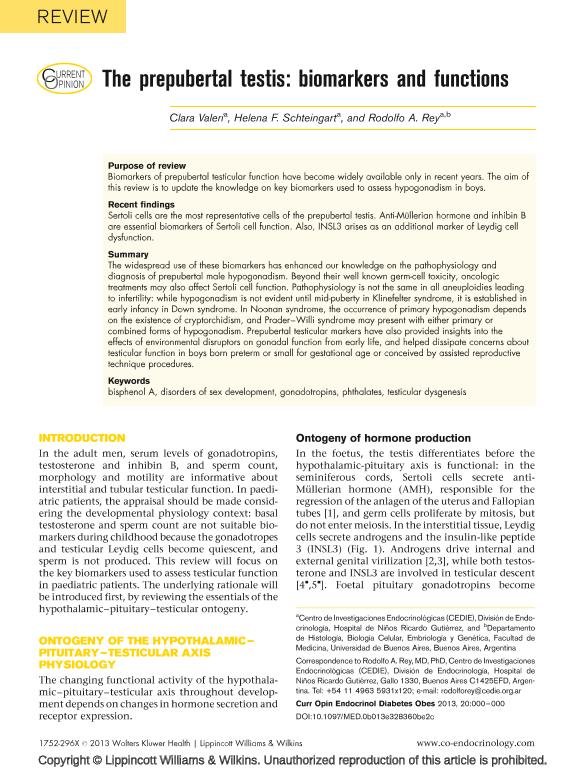Mostrar el registro sencillo del ítem
dc.contributor.author
Valeri, Clara

dc.contributor.author
Schteingart, Helena Fedora

dc.contributor.author
Rey, Rodolfo Alberto

dc.date.available
2015-12-21T17:49:20Z
dc.date.issued
2013-06
dc.identifier.citation
Valeri, Clara; Schteingart, Helena Fedora; Rey, Rodolfo Alberto; The prepubertal testis: Biomarkers and functions; Lippincott Williams; Current Oppinion In Endocrinology And Diabetes; 20; 3; 6-2013; 224-233
dc.identifier.issn
1752-296X
dc.identifier.uri
http://hdl.handle.net/11336/3107
dc.description.abstract
Purpose of review: Biomarkers of prepubertal testicular function have become widely available only in recent years. The aim of this review is to update the knowledge on key biomarkers used to assess hypogonadism in boys. Recent findings: Sertoli cells are the most representative cells of the prepubertal testis. Anti-Müllerian hormone and inhibin B are essential biomarkers of Sertoli cell function. Also, INSL3 arises as an additional marker of Leydig cell dysfunction. Summary: The widespread use of these biomarkers has enhanced our knowledge on the pathophysiology and diagnosis of prepubertal male hypogonadism. Beyond their well known germ-cell toxicity, oncologic treatments may also affect Sertoli cell function. Pathophysiology is not the same in all aneuploidies leading to infertility: while hypogonadism is not evident until mid-puberty in Klinefelter syndrome, it is established in early infancy in Down syndrome. In Noonan syndrome, the occurrence of primary hypogonadism depends on the existence of cryptorchidism, and Prader-Willi syndrome may present with either primary or combined forms of hypogonadism. Prepubertal testicular markers have also provided insights into the effects of environmental disruptors on gonadal function from early life, and helped dissipate concerns about testicular function in boys born preterm or small for gestational age or conceived by assisted reproductive technique procedures.
dc.format
application/pdf
dc.language.iso
eng
dc.publisher
Lippincott Williams

dc.rights
info:eu-repo/semantics/openAccess
dc.rights.uri
https://creativecommons.org/licenses/by-nc-sa/2.5/ar/
dc.subject
BISPHENOL A
dc.subject
DISORDERS OF SEX DEVELOPMENT
dc.subject
GONADOTROPINS
dc.subject
PHTHALATES
dc.subject
TESTICULAR DYSGENESIS
dc.subject.classification
Endocrinología y Metabolismo

dc.subject.classification
Medicina Clínica

dc.subject.classification
CIENCIAS MÉDICAS Y DE LA SALUD

dc.title
The prepubertal testis: Biomarkers and functions
dc.type
info:eu-repo/semantics/article
dc.type
info:ar-repo/semantics/artículo
dc.type
info:eu-repo/semantics/publishedVersion
dc.date.updated
2016-03-30 10:35:44.97925-03
dc.journal.volume
20
dc.journal.number
3
dc.journal.pagination
224-233
dc.journal.pais
Reino Unido

dc.journal.ciudad
Londres
dc.description.fil
Fil: Valeri, Clara. Consejo Nacional de Investigaciones Científicas y Técnicas. Oficina de Coordinación Administrativa Parque Centenario. Centro de Investigaciones Endocrinológicas; Argentina
dc.description.fil
Fil: Schteingart, Helena Fedora. Consejo Nacional de Investigaciones Científicas y Técnicas. Oficina de Coordinación Administrativa Parque Centenario. Centro de Investigaciones Endocrinológicas; Argentina
dc.description.fil
Fil: Rey, Rodolfo Alberto. Consejo Nacional de Investigaciones Científicas y Técnicas. Oficina de Coordinación Administrativa Parque Centenario. Centro de Investigaciones Endocrinológicas; Argentina. Universidad de Buenos Aires. Facultad de Medicina. Departamento de Biología Celular e Histología; Argentina
dc.journal.title
Current Oppinion In Endocrinology And Diabetes

dc.relation.alternativeid
info:eu-repo/semantics/altIdentifier/doi/http://dx.doi.org/doi:10.1097/MED.0b013e328360be2c
dc.relation.alternativeid
info:eu-repo/semantics/altIdentifier/url/https://journals.lww.com/co-endocrinology/Abstract/2013/06000/The_prepubertal_testis__biomarkers_and_functions.11.aspx
Archivos asociados
